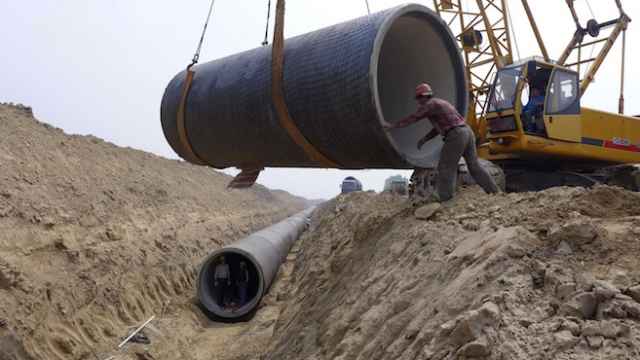The number of times Japanese fighter jets scrambled to ward off Russian military aircraft more than doubled in the last six months, amid diplomatic tensions between the two countries which Prime Minister Shinzo Abe is keen to ease.
The increased activity in Japan's north also comes as the armed forces pivot their focus southwards towards China, the assertive Asian giant which is seen in Tokyo as the more immediate challenge.
According to government figures released this week, instances of fighter jets scrambling into the skies above Japan jumped by 73 percent in the six months through September, led by sorties confronting Russian bombers and spy planes.
Scrambles jumped to 533 from 308 a year earlier, the Defense Ministry said, and the total is on course to surpass figures seen during the last fiscal year, themselves the highest in nearly a quarter of a century.
Flights dispatched specifically to meet Russian aircraft in the latest six months soared to 324 from 136, although they eased during the second half of the period under review.
"We don't know the reason for the increased air activity. That's something for the Russians to answer," said a Self-Defense Forces official, who declined to be identified under ground rules for a recent press tour of facilities in Hokkaido.
The official would not discuss the circumstances surrounding the surge in scrambles against Russia.
The Russian Defense Ministry failed to answer repeated telephone calls made on Wednesday for comment.
Territorial Dispute
Hokkaido is a Japanese island to the north of the country's main land mass, and it lies close to four smaller islands which are claimed both by Japan and Russia.
The territorial dispute has prevented Japan and Russia from concluding a formal peace treaty and helps explain Japan's north-facing military posture, with mechanized infantry divisions and tank brigades set up to repel a feared Soviet invasion.
Besides economic and energy ties, Abe's diplomacy aims at resolving the dispute over the islands that Moscow seized in the final days of World War II.
That task is being complicated by Japan's decision to join Western sanctions against Moscow for its annexation of the Crimea peninsula in March and its involvement in a pro-Russian rebellion in eastern Ukraine.
Moscow denies sending troops and arms to the area.
However, Tokyo's measures against Russia have been lighter than those of the United States or the European Union.
Abe said Wednesday he hoped to meet President Vladimir Putin at an Asia-Europe summit this week, and the two are expected to meet at a Pacific Rim gathering next month.
Only Minutes to Intercept
Russian aircraft often fly a circuitous route around the long Japanese archipelago.
Countering them are fighter jets, including two squadrons of Japanese F-15 fighter jets, around 40 aircraft, at Chitose air base, less than 200 miles from the Russian border.
Incursions in Japan's northern air zone in the latest six months rose to 189 from 110 a year earlier.
Capable of flying at two and a half times the speed of sound, the F-15s can intercept Russian aircraft within minutes. Pilots, alerted by phone, dash to waiting F-15s using afterburners to speed their ascent.
The unexpectedly high number of overflights by Russian aircraft from the north comes as Japan is thinning out its forces in Hokkaido in order to focus more on China.
Its 700-strong tank force, for example, is to shrink by 300 vehicles, with a similar cut in the number of howitzer artillery pieces.
Army units such as the second division in Asahikawa, which is closer to Khabarovsk than to Tokyo, have to make do with older equipment while new spending goes to pay for amphibious assault vehicles, troop-carrying aircraft and new mobile armored vehicles destined for units in the southwest.
Northern troops, three-quarters of whom are Hokkaido natives used to training in waist-deep snow, are being told to look to the subtropical south.
As a result of the pivot, logistics officers in Hokkaido must devise plans to ship their units and equipment south at short notice should they be needed during an emergency.
Russia's ability to prod Japan's northern defenses, meanwhile, may increase. Moscow plans to spend as much as a fifth of its national budget on defense by 2018. That means an 18 percent increase in military outlays this year followed by 33 percent more over the next two budget terms.
A Message from The Moscow Times:
Dear readers,
We are facing unprecedented challenges. Russia's Prosecutor General's Office has designated The Moscow Times as an "undesirable" organization, criminalizing our work and putting our staff at risk of prosecution. This follows our earlier unjust labeling as a "foreign agent."
These actions are direct attempts to silence independent journalism in Russia. The authorities claim our work "discredits the decisions of the Russian leadership." We see things differently: we strive to provide accurate, unbiased reporting on Russia.
We, the journalists of The Moscow Times, refuse to be silenced. But to continue our work, we need your help.
Your support, no matter how small, makes a world of difference. If you can, please support us monthly starting from just $2. It's quick to set up, and every contribution makes a significant impact.
By supporting The Moscow Times, you're defending open, independent journalism in the face of repression. Thank you for standing with us.
Remind me later.






